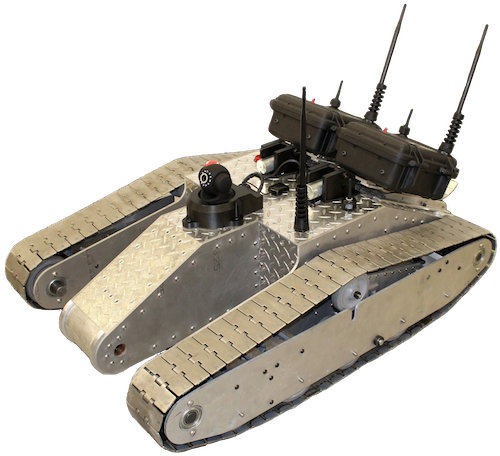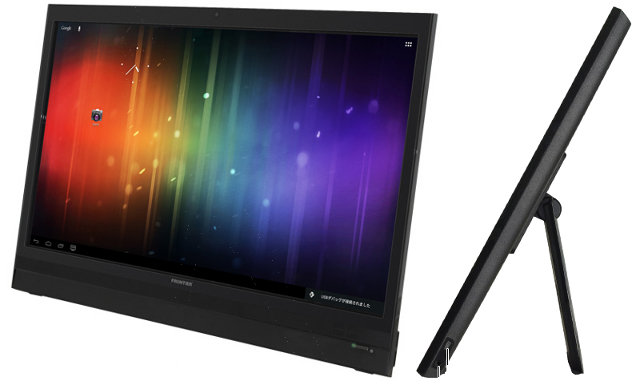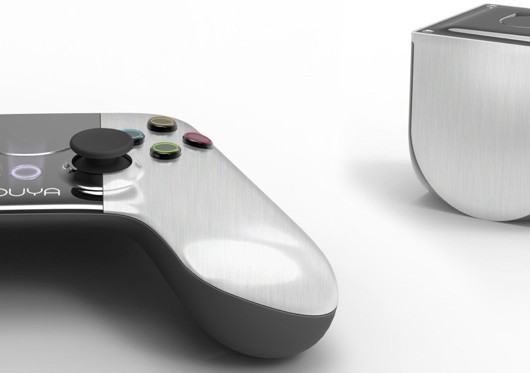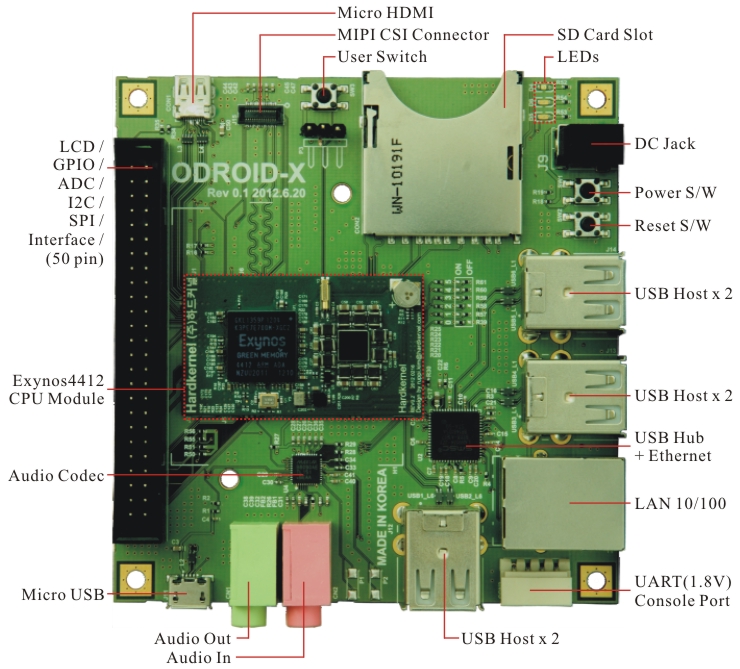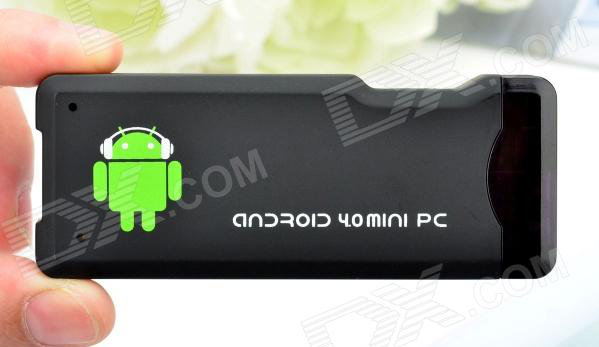Following this morning announcement, I’ve started to build XBMC for Android using the instructions on XBMC Android github repository, but it takes hours on my machine. In the meantime, I’ve found a prebuilt apk that I’ve tried on my Mele A1000 and shot a (super blurry) video. This is still a development version, so there are a lot of bugs, but it shows good progress. The user interface renders at 28 fps and it’s very smooth, although CPU usage is about 65%. The remote control can work properly, but XBMC does not respond to mouse clicks and keyboard input. It can find UPNP servers (Windows) and locate your file. SMB client crashes XBMC on my system I’ve tried Big Buck Bunny 480p, 720p and 1080p, and none of the sample can play smoothly, so NEON software decoding does not appear to be fast enough to play videos smoothly. The APK […]
WiFi Tank Based on EEE PC, Arduino, Ubuntu and Node.js
Eight computer and electrical engineers built a WiFi Tank (Node.js robot) as part of a senior design project at Northeastern University, in Boston, Massachusetts. The robot brain is an EEE PC running Ubuntu, together with an Arduino board and is programmed using node.js. Each tank is equipped with a camera and 2 customized Wi-Fi repeaters (which it can drop it extend range), and it’s targeted at military operations or disaster-affected areas where network infrastructure is not available. Here are the key characteristics of this robot Robot controlled over WiFi 102 cm long, 71 cm wide, 41 cm tall, about 68 kg. Custom-built (except for treads) out of aluminum Range: 1 km with one on-board router and two droppable long-range repeater modules Running time: ~12 hours On-board webcam with microphone, night vision, pan and tilt On-board GPS for location tracking Custom-made remote user interface, works on any device with a web […]
XBMC Media Center Coming to Android
I’ve received a mysterious picture this morning without further details… After a little Google search, it appears XBMC has announced their progress on XBMC for Android. There was already XBMC remote and thin client available on Google Play, but the latest announcement is the real deal, and XBMC can be launched on you Android based devices be it a set-top box, a tablet, a phone, or whatever… It will be the same user experience as on the desktop Have a look at a short (and blurry) teaser video showing XBMC running in Android. “Big Buck Bunny” video is to media player what Angry Birds is to tablet, it has to be shown during demos… XBMC developers explain that most devices only support software decode of audio and video for now, but expect on OpenMAX based player to eventually be available. The main development platform was a Pivos XIOS DS set-top-box […]
Frontier FT103 21.5″ Android SmartDisplay
Frontier, a Japanese company, launched a 21.5″ Smartdisplay running Android 4.0 powered by Texas Instruments OMAP4428 application processor with 1 GB RAM and 8 GB Flash. Here are the specifications of this giant Android tablet: Processor – Texas Instruments OMAP 4428 dual core Cortex A9 @ 1 GHz System memory – 1 GB Storage – 8 GB Flash + SD card slot (Up to 32 GB) Display – 21.5″ TFT LCD touch panel (maximum resolution: 1920 x 1080) USB – microUSB (stereo mini jack) USB2.0 + 2x USB 2.0 Host ports. Audio I/O – Built-in Microphone, built-in stereo speakers (1W + 1W) and headphone jack. Connectivity 10/100 MBit Ethernet Wifi 802.11 b/g/n Bluetooth ® Ver.2.1 + EDR Camera – 1.2 MP Webcam Power Supply – AC adapter (19V, 2.1A) Dimensions – 512.8 x 353 x 24.8 mm Weight – 5.0 kg The company does not expect you to carry this […]
$99 OUYA Android 4.0 Open Source Hackable Video Game Console
More and more new games are targeted to mobile devices such as smartphones and tablets running Android and iOS, and less games are developed for standard gaming console. To work around this issue, OUYA is working on a gaming console based on Android ICS called .. well… OUYA, and posted the project on Kickstarter to complete development and start manufacturing. Here are OUYA Specifications: Nvidia Tegra3 quad-core cortex A9 processor 1 GB RAM 8 GB of internal flash storage HDMI port (up to 1080p HD) WiFi 802.11 b/g/n Bluetooth LE 4.0 USB 2.0 port Wireless controller with standard controls (two analog sticks, d-pad, eight action buttons, a system button), a touchpad Android 4.0 Although you may just think it will just run existing Android games, the company expects the device to bring higher end games such as the ones available on console. Each box will be a development kit, and developers […]
HardKernel ODroid-X: Low Cost Exynos 4412 Quad Core Cortex A9 Development Board
HardKernel unveiled the ODROID-X development board based on Samsung Exynos 4412 quad-core ARM Cortex-A9 with quad core Mali-400 GPU, 1 GB Low Power DDR2 and storage is done via SD card and/or eMMC flash. Here are ODROID-X development board specifications: Processor Samsung Exynos4412 Cortex-A9 Quad Core 1.4Ghz with 1MB L2 cache Memory 1024MB(1GB) LP-DDR2 800MB/s data rate GPU Quad Core Mali-400 Video supports 1080p via HDMI cable (H.264+AAC based MP4 container format) Video Out micro HDMI connector / RGB-24bit LCD interface port Audio Standard 3.5mm headphone jack and microphone jack HDMI SPDIF LAN 10/100Mbps Ethernet with RJ-45 Jack (Auto-MDIX support) USB2.0 Host High speed standard A type connector x 6 ports USB2.0 Device ADB/Mass storage(Micro USB) UART System console monitoring for development (1.8volt interface) IO PORTs 50pin IO expansion port for LCD/I2C/UART/SPI/ADC/GPIO interfaces Display (Option) HDMI monitor / LCD panel with RGB or LVDS interface Storage (Option) Full size SDHC […]
72.90 USD AK802 Android Mini PC with AllWinner A10 and 1GB RAM
No, it’s not a typo in the title, and I did not mean to write “MK802”, but a company (which does not appear to be Rikomagic) released a product called AK802 which looks very similar (not to say exactly) the same, but comes with 1GB by default. Here are the specifications of the device partially taken from Dealextreme, so there must be an error somewhere, we just need to find out where ;). CPU AllWinner A10 @ 1.5GHz + Mali 400 GPU Memory 1 GB RAM Storage 4 GB Flash microSD slot (Up to 32 GB) Connectivity WiFi 802.11b/g USB micro USB 2.0/OTG port USB 2.0 Host port Video output HDMI (up to 2160p) Video Codecs & Containers WMV, ASF, MP4, 3GP, 3G2M4V, AVI, MJPEG, RV10, DivX/VC-1, MPEG-2, MPEG-4, H.263, H.264/1280*720P HD 30 fps, 1080P/720*480 D1 30fps Audio Codecs AAC, AAC+, eAAC+, AMR-NB, AMR-WB, QCP, MP3, WMA, WAV, MIDI, M4A […]
Olimex Offers Up to 50% Discount on OLinuXino Boards to Open Source Developers
Olimex has been providing low cost MCU devkits for many years, and this year they started offering more powerful embedded Linux development boards called OLinuXino. The first family (iMX233-OLinuXino) is based on Freescale i.MX233 ARM9 processor @ 454 Mhz and comes in three form factor: iMX233-OLINUXINO-MAXI – 2x USB host, Ethernet, TV-out, GPIOs, SD-CARD, Audio-In, Audio-Out, UEXT – 44.95 Euros. iMX233-OLINUXINO-MINI – 3x USB host, TV-out, GPIOs, SD-CARD, Audio-In, Audio-Out, UEXT – 34.95 Euros iMX233-OLINUXINO-MICRO – USB host, TV-out, GPIOs, SD-CARD, ready for breadboaring – 23.95 Euros They are also working on A13-OLinuXino board featuring AllWinner A13 Cortex A8 processor. To promote their new boards (and reward open source developers – cf comment below), the company company has decided to offer discount to open source developers. The way I understand it: you need to buy a board first, publish the source code somewhere and write about it on your own […]



